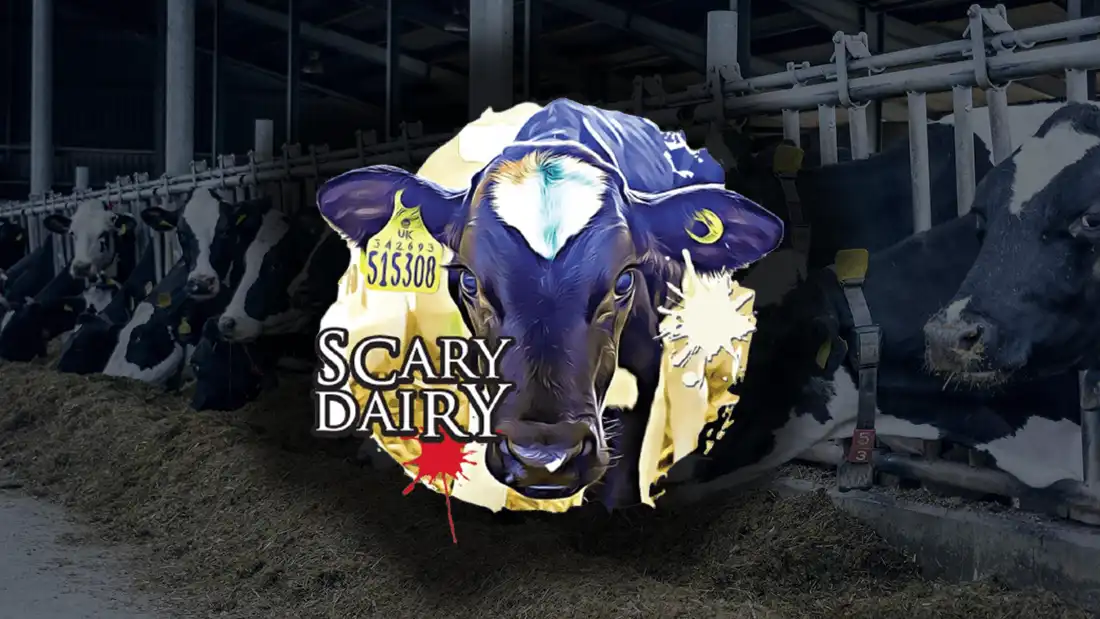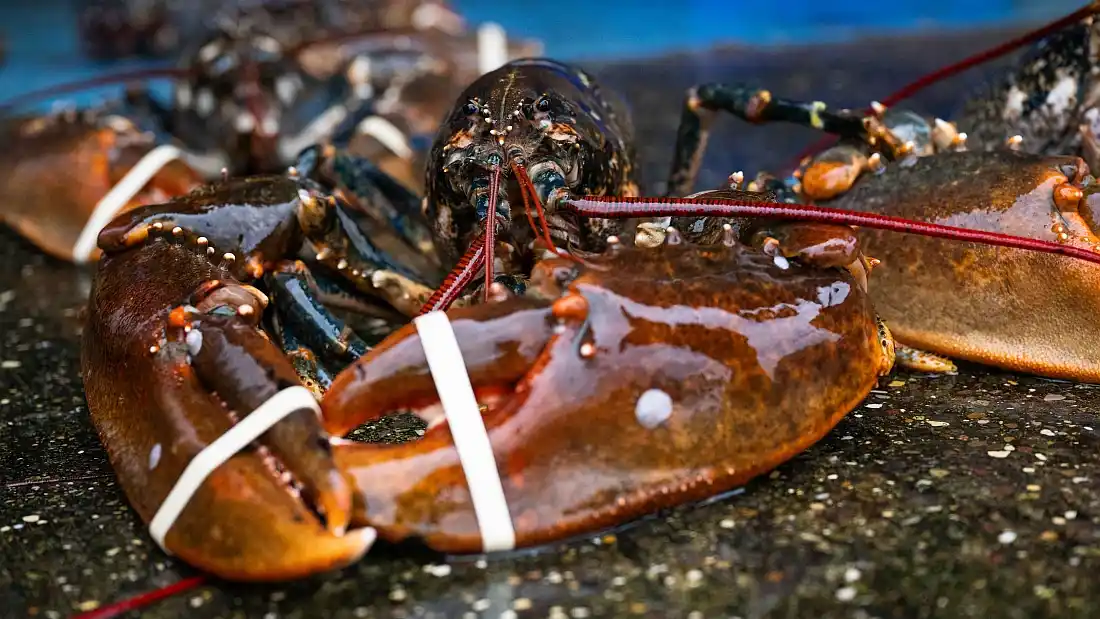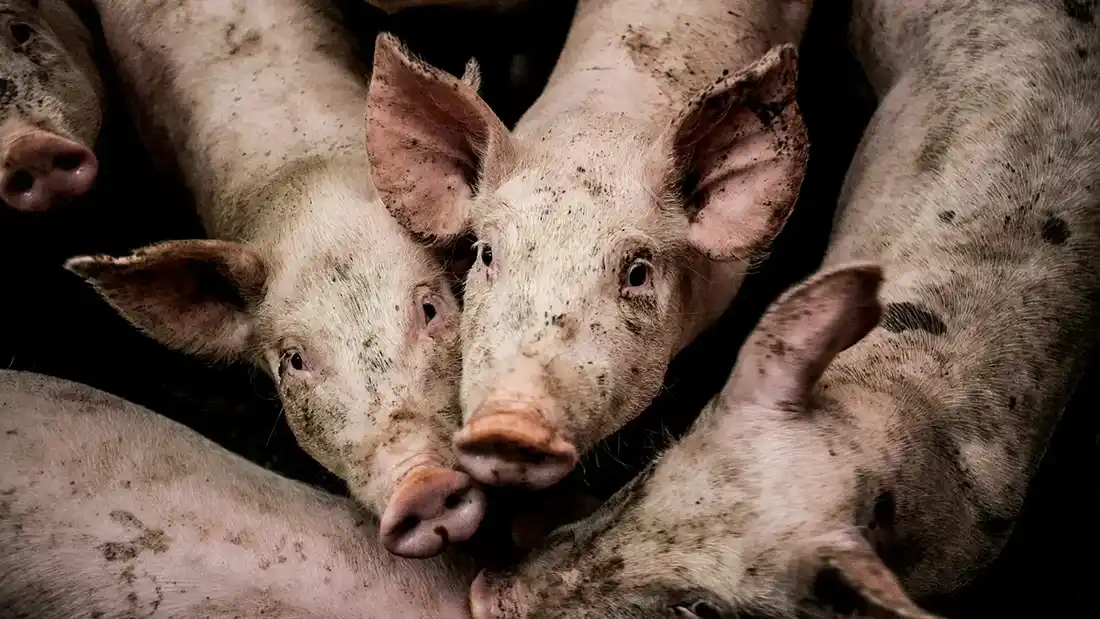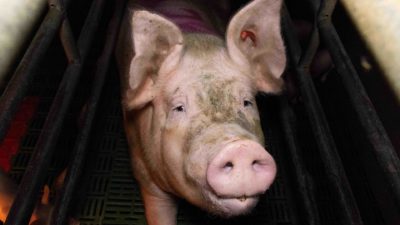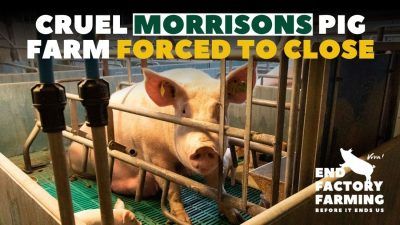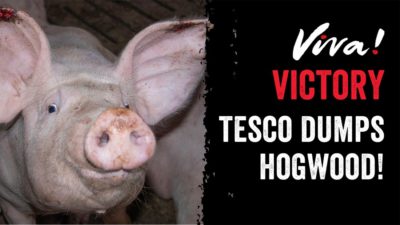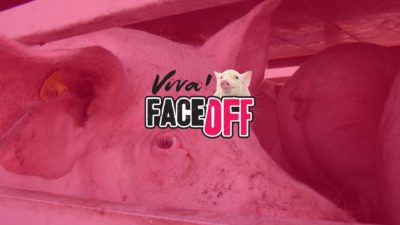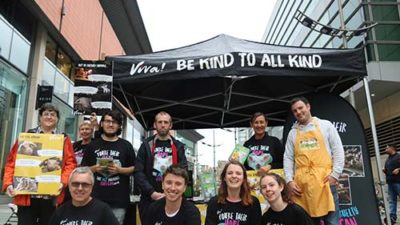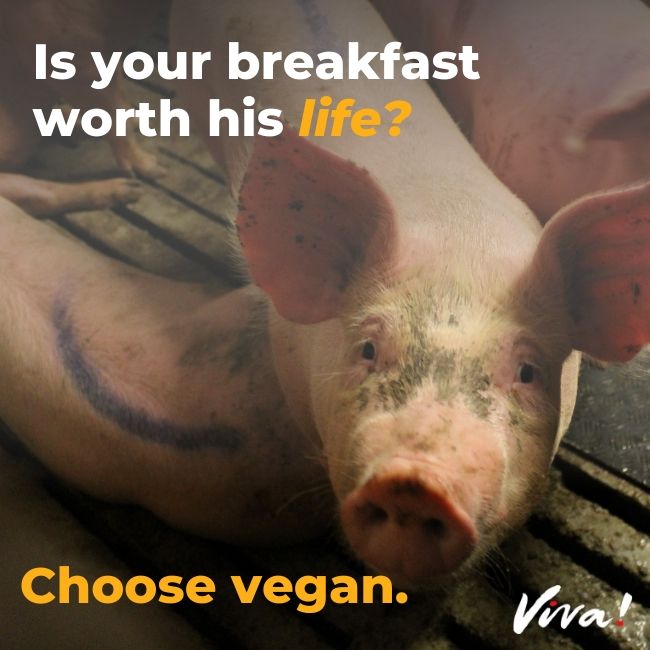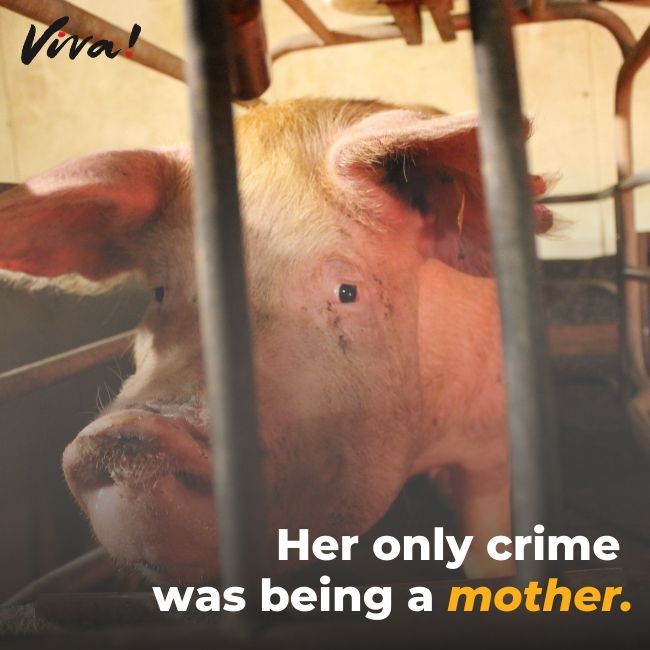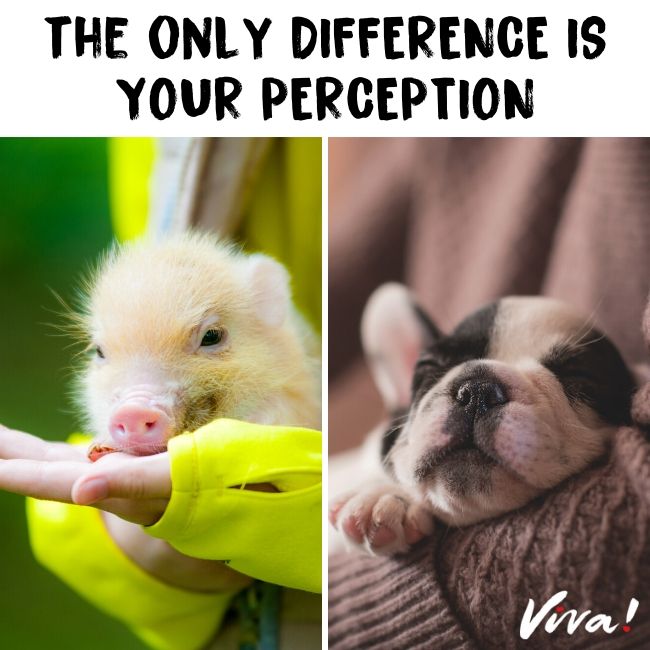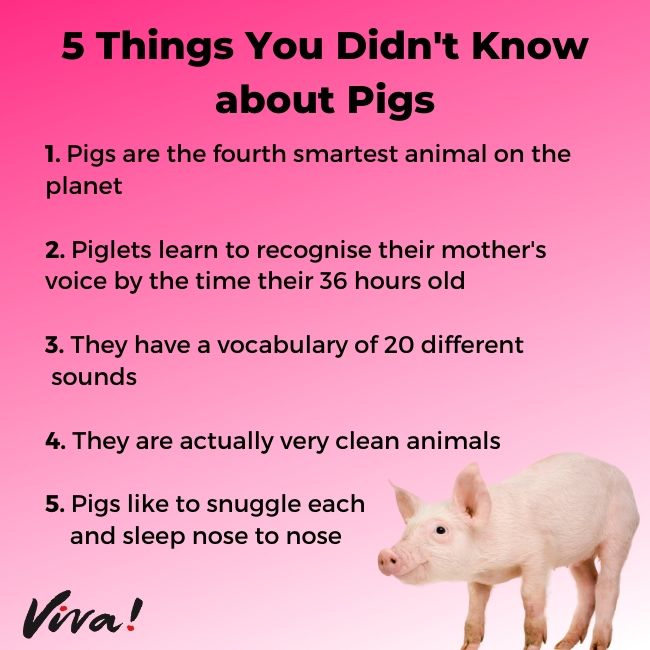How Pigs Are Farmed and Killed

Summary
Pigs are one of the most intelligent, sensitive and social species on the planet. Just like us, they feel empathy for one another and form very strong bonds with their babies. Farming pigs in the way we do, strips away their right to fulfil any of their natural instincts, their right to be free, to express their personalities, to love each other in their close knit family groups and of course, ultimately to live at all. Rooting in the mud is replaced by snouts probing at bare concrete floors, whilst a sow’s lovingly-made nest is replaced with a cold metal cage. The joy of motherhood is transformed into a production line.
The UK prides itself on having some of the best welfare of farmed animals in the world, and yet there is nothing kind, or natural, about the way we farm pigs. Even for those ‘lucky’ few who get to be born outside, they still spend most of their lives in crowded, dark sheds to be gassed to death by the time they are just six months old.
The intensification of pig farming is increasing and diseases, injuries and its environmental impact are also inevitably increasing with dire consequences for everyone. There is one option that ensures you do not contribute to the death and suffering of these clever and fascinating animals, and that is to go vegan.
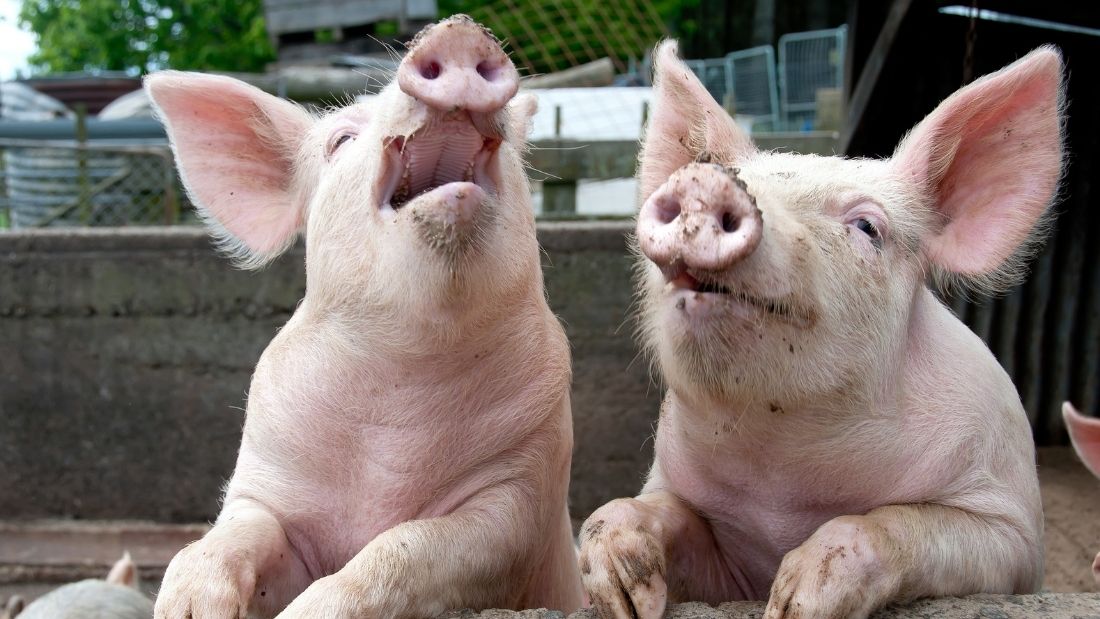
- Pigs are one of the most intelligent species on earth. They are smart, and sometimes smarter than, dogs, primates, dolphins and even human toddlers. They can even be taught to play computer games!9Croney, C.C. 1999. Cognitive abilities of domestic pigs. Thesis in Animal Science, The Pennsylvania State University, College of Agricultural Sciences, 1–105.
- Pigs are incredibly playful and just like puppies, piglets will scamper, jump, hop, play-fight, push and run after each other!10Dudink, S., Simonse, H., Marks, I., de Jonge, F.H., & Spruijt, B.M. 2006. Announcing the arrival of enrichment increases play behavior and reduces weaning-stress-induced behaviours of piglets directly after weaning. Applied Animal Behaviour Science, 101, 86–101. 14.11Newberry, R.C., Wood-Gush, D.G.M., & Hall, J.W. 1988. Playful behavior in piglets. Behavioural Processes, 17, 205–216. Adult pigs will run and dance with joy when given the freedom to do so. They also wag their tails when they’re happy!12Masson, JM, 2019. The Secret World of Farm Animals. Vintage. p.26
- Pigs are highly sensitive and emotional. They pick up on the emotions of other pigs in their group and can feel empathy for them in the same way as other socially complex species, such as dogs, wolves, great apes and ourselves.13Marino, L., & Colvin, C. M. 2015. Thinking pigs: A comparative review of cognition, emotion, and personality in Sus domesticus. International Journal of Comparative Psychology, 28, Article 2385914Reimert, I., Bolhuis, J. E., Kemp, B., & Rodenberg, T. (2013). Indicators of positive and negative emotions and emotional contagion in pigs. Physiology and Behavior, 109, 42–50.
- Despite their reputation, pigs are very clean and hygienic. Even a one-day-old piglet will leave the warmth of his or her mother to urinate away from the nest.15Doherty J. 2010. The Private Life of Pigs. BBC Two. Available at: https://www.bbc.co.uk/programmes/b00t3tl1
- Pigs have (almost) no sweat glands. With just a few on their noses, they find it difficult to regulate their temperature and that’s why, given the chance, they’ll roll in mud on a hot day to keep cool and protect themselves from sun damage.
- A pig’s sense of smell is 2,000 times more powerful than a human’s. They can smell a human up to a quarter of a mile away and locate roots and tubers that are deep underground.5Marino, L., & Colvin, C. M. 2015. Thinking pigs: A comparative review of cognition, emotion, and personality in Sus domesticus. International Journal of Comparative Psychology, 28, Article 238597Doherty J. 2010. The Private Life of Pigs. BBC Two. Available at: https://www.bbc.co.uk/programmes/b00t3tl1
- Mother pigs ‘sing’ to their babies while nursing, making particular and continuous grunts which get faster until their milk stops flowing. New-born piglets learn to run to their mum’s voice.16Algers, B & Jensen, P. 1985. Communication during suckling in the domestic pig. Effects of continuous noise. Applied Animal Behaviour Science. 14, 49-61
- Pigs are extremely tactile and love nothing more than a good back scratch, massage or belly rub!4Masson, JM, 2019. The Secret World of Farm Animals. Vintage. p.26

The Intelligence of Pigs
Pigs are one of the most intelligent species on earth, alongside primates, dolphins and humans.1Marino, L., & Colvin, C. M. 2015. Thinking pigs: A comparative review of cognition, emotion, and personality in Sus domesticus. International Journal of Comparative Psychology, 28, Article 23859 They can even perform some tasks better than human toddlers!2BBC Earth. 2014. Smart Pigs vs Kids | Extraordinary Animals. Available online at: https://www.youtube.com/watch?v=mza1EQ6aLdg
They can be taught to play computer games by using a joystick and in one study, outperformed dogs in manipulating a joystick to hit on-screen targets.3Croney, C.C. 1999. Cognitive abilities of domestic pigs. Thesis in Animal Science, The Pennsylvania State University, College of Agricultural Sciences, 1–105. Just like dogs and dolphins, pigs can learn to carry out specific commands, such as fetching a ball and jumping through a hoop.4Cerbulis, I.G. 1994. Cognitive abilities of the domestic pig (Sus scrofa), Thesis in Department of Psychology, Ohio State University, 1–108.
Only the world’s most intelligent animals can recognise their own reflection – dolphins, bonobos, orangutans and elephants, are members of that brainy club. However, pigs could potentially be added to this list too. In tests, piglets of just six weeks old used a mirror to locate food behind them that was only visible in the mirror, suggesting that they are aware of their reflection.5Broom, D. 2010. Cognitive ability and awareness in domestic animals and decisions about obligations to animals. Applied Animal Behavior Science, 126, 1–11.
Playful and curious
Pigs are social, playful and curious. Whilst farmed pigs may all seem to look the same, they have individual personalities. In the same way as dogs (and all vertebrates), different pigs will often react differently to the same situation, depending on their personality.6Forkman, B., Furuhaug, I.L., & Jensen, P. 1995. Personality, coping patterns, and aggression in piglets. Applied Animal Behaviour Science, 45, 31–42.7Gosling, S. & John, O.P. 1999. Personality dimensions in nonhuman animals. Current Directions in Psychological Science, 8, 69–75 One pig may be independent and tough, and another shy and sensitive.8Masson, JM, 2019. The Secret World of Farm Animals. Vintage. p.28-9
Just like puppies, piglets love to play and will chase each other, play-fight and play with objects like sticks and balls.1Marino, L., & Colvin, C. M. 2015. Thinking pigs: A comparative review of cognition, emotion, and personality in Sus domesticus. International Journal of Comparative Psychology, 28, Article 23859 Even adult pigs will joyously frolic in fields when given the opportunity. The compulsion to play is a sign of being able to reason and denying it leads to behavioural abnormalities in later life.

Pigs communicate with each other with different oinks, grunts and squeals for different situations, from saying ‘hello’ to a potential mate, to warning others of danger and yelling ‘I’m hungry!’. They also use different types and frequency of grunts, depending on their personality type, so no two ‘hellos’ are the same.9Friel M, Kunc HP, Griffin K, Asher L, Collins LM. 2016. Acoustic signalling reflects personality in a social mammal. Royal Society journal Open Science. It’s not just vocal communication either – pigs signal to each other through body language and scent-marking.
Their sociability allows pigs to pick up on each other’s emotions and feel a basic form of empathy. Pigs will visibly react to the ‘mood’ of others in their group, whether excited or distressed, even if they don’t know the cause.10Reimert, I., Bolhuis, J. E., Kemp, B., & Rodenburg, T. B. (2014). Emotions on the loose: emotional contagion and the role of oxytocin in pigs. Animal Cognition. Domestic pigs have been known to come to the rescue of other pigs being harmed, and there have even been documented instances of farmed pigs trying to save one another from slaughter.8Masson, JM, 2019. The Secret World of Farm Animals. Vintage. p.28-911Lo, T. 2018. Saving the bacon! Extraordinary moment pig tries to stop its friend from being slaughtered. Available at: https://www.dailymail.co.uk/news/article-5259419/Pig-rescues-friend-thats-slaughtered.html
Not only can pigs feel empathy for the pleasure or plight of other pigs, but they are astute enough to be able to manipulate one another when they need to. Pigs have the ability to trick other pigs to protect their own food source, an indication of sharp minds seen in other highly intelligent creatures such as dogs, chimpanzees and jays.1Marino, L., & Colvin, C. M. 2015. Thinking pigs: A comparative review of cognition, emotion, and personality in Sus domesticus. International Journal of Comparative Psychology, 28, Article 23859
Pigs have excellent memories and can worry about future events.12Imfeld-Mueller, S., Van Wezemaela, L., Stauffachera, M., Gygax, L., & Hillmann, E. 2011. Do pigs distinguish between situations of different emotional valences during anticipation? Applied Animal Behavior Science, 131. They can also remember when someone has treated them well, can distinguish between familiar and unfamiliar human faces and will choose a gentle handler over an unfamiliar stranger using their sight, hearing and smell.13Hemsworth, P.H., Coleman, G.J., Cox, M.L., & Barnett, J.L. 1994. Stimulus generalization: The inability of pigs to discriminate between humans on the basis of their previous handling experience. Applied Animal Behavior Science, 40, 129–142 They can even remember people that they’ve met up to three years earlier.8Masson, JM, 2019. The Secret World of Farm Animals. Vintage. p.28-9
As foraging animals, pigs use ‘mental maps’ to search for objects, or food. In studies, pigs could remember where food was hidden after two hours,14Mendl, M., Laughlin, K., & Hitchcock, D. 1997. Pigs in space: spatial memory and its susceptibility to interference. Animal Behaviour, 54, 1491–1508. and could remember objects for five days or more.15Gifford, A., Sylvie Cloutier, K., & Newberry, R.C. 2007. Objects as enrichment: Effects of object exposure time and delay interval on object recognition memory of the domestic pig. Applied Animal Behaviour Science, 206–217.
The intelligence of pigs is well documented and they are often considered to be the fourth most intelligent non-human animal in the world, following chimps, dolphins and elephants. Our knowledge about their intelligence, sensitivity and sociability contrasts sharply with the way that we treat them in commercial farming.
Pigs have the ability to think, feel, make decisions, remember and worry about future events. The more we learn about the inner lives of pigs, the more we realise that they experience the world in many of the same ways that we do.
Domestic pigs have come a long way from their ancient past. They are descended from the huge group of Artiodactyls, that includes hippopotamuses, camels, giraffes, antelopes, sheep, goats and cattle. They belong to the Suidae (swine) family. The pigs we see in farms today are most closely related to just one species of suid – the wild boar, or ‘wild pig’ (Sus scrofa).
Wild boar once roamed Europe, Asia, North Africa and the Malay archipelago and their domestication first began over 10,000 years ago.1Caliebe, A, Nebel, A., Makarewicz, C. et al. 2017. Insights into early pig domestication provided by ancient DNA analysis. Sci Rep 7. There are now 16 subspecies of wild boar around the world, mainly living in parts of Europe, Asia and Africa.
Over time, there was much selective breeding between Asian and European boars for maximum growth, meat, and reproduction but despite this, you can still see many wild boar traits in today’s domestic pigs.
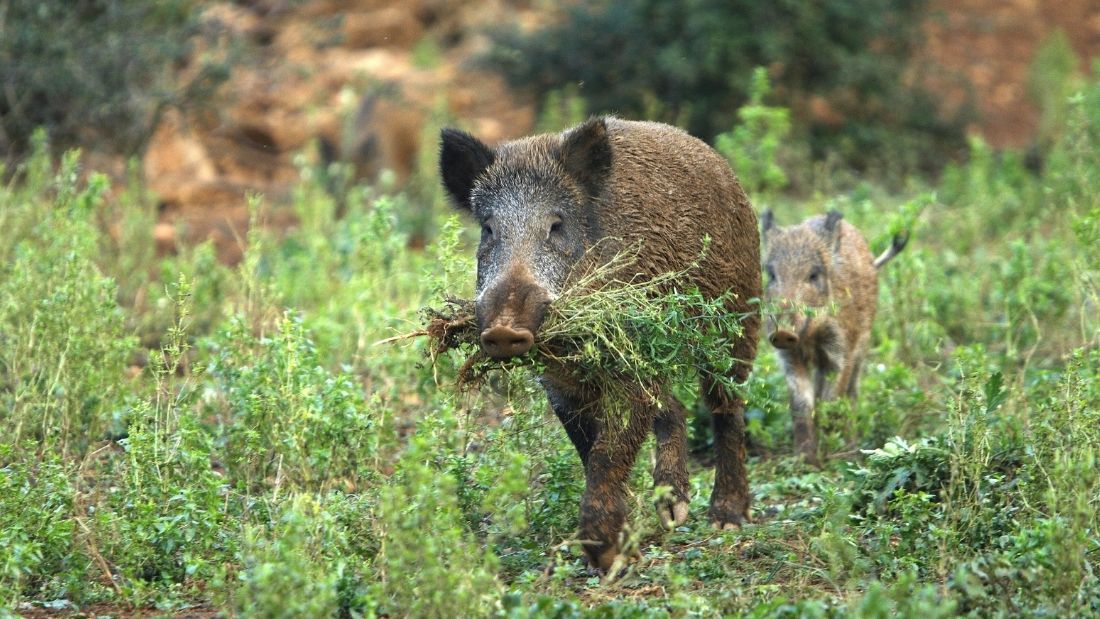
Natural habitat
A wild boar’s natural habitat is moist forests and shrublands, especially oak forests and areas where reeds are abundant. Although they are naturally omnivores, around 90 per cent of their diet is made up of vegetable matter, such as fruit, seeds, roots and tubers.2Oliver W. and Leus K. 2008. Sus scrofa. The IUCN Red List of Threatened Species. Available at: https://www.iucnredlist.org/species/41775/10559847 [Accessed 31 May 2020]
Rooting
‘Rooting’ is the word to describe the natural behaviour of pig’s disturbing the soil or mud by pushing with their snout in search of food. In the wild, they will push up roots to eat, turning over and churning up the soil as they do so.
Wild boar are wide-roaming and mostly active in the early morning and late afternoon. They spend between four and eight hours a day rooting and foraging, sometimes travelling over thousands of hectares in a matter of months to find fresh food.3Masson J. 2002. The Secret Life of the Pig: the Emotional World of Farm Animals. Random House.
The rooting instinct is still just as powerful in commercially farmed pigs and Viva! has seen just how fundamental this is in the animals we have rescued. It is, of course, entirely denied in factory farms where pigs’ noses are met with concrete and slatted floors.
Birth in the wild
Wild boars live in groups called ‘sounders’, usually made up of six to 20 pigs. Adult males will only visit the sounder to mate, so sows travel in matriarchal units made up of one or two adult female sows and their litters. Males travel long distances to find females with which to mate, and will fight rival males for mating rights.
Wild boar sows are usually pregnant for between 114 and 140 days, depending on the age of the sow. When she is about to give birth, she will leave the sounder to build a nest out of twigs and vegetation. Given the opportunity, you will see farmed pigs carrying out the same behaviour days before they give birth.
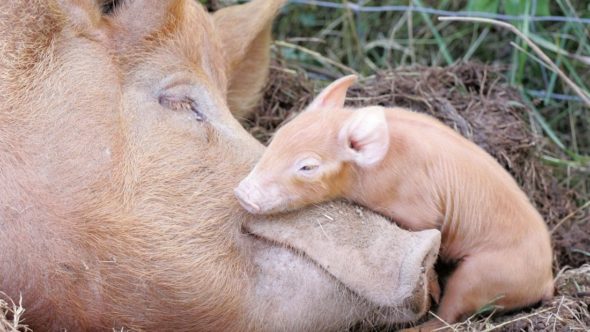
The average litter size in the wild is between four and seven piglets. When born, they latch on to a teat and within 48 hours will have establish a ‘teat order’ and from then on, every piglet will stick to his or her own individual teat until weaned.4Masson, JM, 2019. The Secret World of Farm Animals. Vintage. p.46 Piglets are born with stripes on their backs to camouflage them from predators but these gradually fade out as they get older to be replaced with thick, wiry black fur.
Wild boars share maternal duties and if a sow dies prematurely, others sows in the sounder will adopt her babies.5Marsan, Andrea; Mattioli, Stefano 2013. Il Cinghiale (in Italian). Il Piviere (collana Fauna selvatica. Biologia e gestione).pp. 83–86 Sows are very protective of their young and will charge predators that come close. You can still see this behaviour in domestic pigs when another animal or person comes too close to their litter.
Threats
Humans are, and have been for thousands of years, wild boars’ greatest threat. Throughout human civilization, boars have been hunted for their meat and even today in much of Europe it is legal to hunt them.
The grey wolf, coyote, black bear, brown bear, lynx, bobcat, cougar, and jaguar, are the wild boar’s main predators in most of its natural range throughout the world.
How long do pigs live in the wild?
The lifespan of a wild boar can vary between four to 12 years in the wild.5Marsan, Andrea; Mattioli, Stefano 2013. Il Cinghiale (in Italian). Il Piviere (collana Fauna selvatica. Biologia e gestione).pp. 83–86 In captivity such as zoos, they can live for up to 20 years as they have no predators.6Baskin, L.; Danell, K. (2003). Ecology of Ungulates: A Handbook of Species in North, Central, and South America, Eastern Europe and Northern and Central Asia. Springer Science & Business Media. pp. 15–38.
Wild Boar in the UK

Wild boar once roamed the forests of Northern Europe and in the Bronze Age they were abundant in the UK. By the 17th century they had been hunted to extinction.
Incredibly, wild boar returned to the UK in the 1990s, mostly as a result of escaping from boar farms. There is now a population of around 2,600 wild boar in small pockets of the UK.7Woodland Trust. 2020. Wild boar. Available online at: https://www.woodlandtrust.org.uk/trees-woods-and-wildlife/animals/mammals/wild-boar/ [Accessed 29th May 2020]
Despite their very small numbers, there have been increasing calls for them to be culled in two of their most established habitats – the Forest of Dean in Gloucestershire, and Stourhead Estate in Somerset. There are concerns about so-called overpopulation as well as reports of aggression towards dog walkers.
In producing the document ‘Feral Wild Boar in England: An Action Plan’, the UK government’s Defra commissioned risk assessments that included a review of public safety across Europe where significant numbers and densities of boar exist in the wild. That assessment concluded: ‘given their widespread distribution and substantial populations throughout much of their range, the risk of injury and attack is very small’.
Within the Forest of Dean, the experience of the Forestry Commission supports the conclusion of the risk assessment. Risks to public safety are most likely through injuries resulting from road traffic accidents related to feral wild boar; and to less direct impacts such as horses bolting or otherwise reacting to the presence of boar and throwing their riders, or dog walkers being injured whilst ‘rescuing’ their dog from a boar attack.8Forestry Commission, 2015. Feral wild boar in the Forest of Dean. 3 December 2015. Available online at: www.forestry.gov.uk/forestry/infd-9fyfc5 [Accessed 21 February 2016]
Tragically, wild boar in the UK are hunted and shot. In April 2020, culling was underway to kill 400 wild boars in the Forest of Dean.9Forestry England. 2019. More information about wild boar. Available online at: https://www.forestryengland.uk/article/more-information-about-wild-boar
Viva! campaigns to end the Boar War.
There is still small-scale free-range farming of wild boar for meat in the UK. They are killed at around 18 months old and sold to independent butchers or charcuteries. Wild boar are classed under the Dangerous Wild Animals Act of 1976, and therefore anyone farming wild boar must have a special licence issued by their local authority.10Legislation.gov.uk.2007. The Dangerous Wild Animals Act. Available online at: http://www.legislation.gov.uk/uksi/2007/2465/schedule/made
“What perplexes and angers me is the reason why the boar are being killed because I fear that it is a cruel mixture of intolerance and abject ignorance fuelled by some of the most idiotic scaremongering I’ve ever encountered . Why can’t residents find a passive solution to the boars presence? They do in France where I live, there these animals are an accepted and valued part of the community. Why when we perceive that wildlife has become a nuisance do we always reach for the gun rather than work towards a creative compromise? And why don’t journalists actually research their subject or consult experts rather than print ludicrously misleading horror stories? This ‘cull’ is a blight upon the reputation of the residents and managers of this beautiful part of the U.K. It’s embarrassing in a place that calls itself a lover of animals and damages our reputation as conservationists. The monsters in your midst are not the boar , they are all human.”
– Chris Packham, Wildlife TV presenter
Pigs are one of the most eaten animals on the planet, and one of the worst treated, despite being one of the most intelligent.
Across the world, 1.5 billion pigs are slaughtered every year for meat.1Weforum.org. 2019. This is how many animals we eat each year. Available at: https://www.weforum.org/agenda/2019/02/chart-of-the-day-this-is-how-many-animals-we-eat-each-year
In the UK, the majority of pigs spend most of their lives indoors in massive, overcrowded sheds before they are slaughtered at around five to six months old. Sows are forced to give birth to at least two litters a year – usually five litters in two years. After about five years of breeding, they are killed and sold for cheap meat.2Gellatley. J. 2016. Pig Farming the Inside Story. Available at: https://www.viva.org.uk/pig-farming-report/
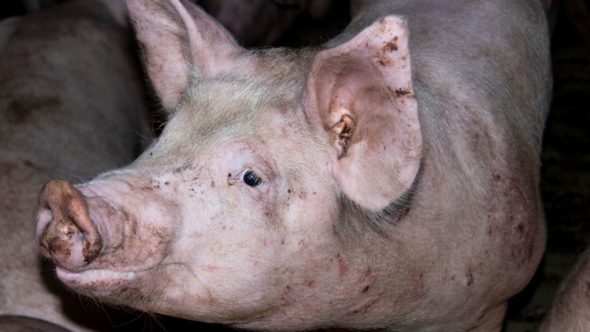
How many pigs are killed in the UK?
Over 10 million pigs are slaughtered every year in the UK.3Agriculture in the UK. 2022. Available at: https://www.gov.uk/government/statistics/agriculture-in-the-united-kingdom-2022/chapter-8-livestock The total pig population here is 3.8 million, of which 3.4 million are bred for meat and around 400,000 are breeding sows and boars.4Defra. 2020. Farming Statistics – Livestock Populations at 1 December 2019, England. Available online at: https://assets.publishing.service.gov.uk/government/uploads/system/uploads/attachment_data/file/868541/structure-dec19-engseries-27feb20.pdf
Commercially-farmed pigs in the UK are mostly hybrids – crosses of the Large White and Landrace breeds – selectively bred for their size, lean meat and their ability to produce large litters.
The UK pig industry
The largest pig farming business in the UK is Tulip Ltd, which owns 30 per cent of the UK market share. They breed and rear 1.5 million pigs a year.5Tulipltd.com. How we do it. Available at: https://www.tulipltd.co.uk/how-we-do/ [Accessed 31 May 2020]
There are around 10,000 pig farms in the UK, but 92 per cent of production comes from about 1,600 so-called ‘assured farms’, many of which belong to 10 corporate companies and they account for 35 per cent of breeding sows.6Pork.ahdb.org.uk. 2020. Pig production. Available at: https://pork.ahdb.org.uk/pig-production/ [Accessed 25 May 2020]
Despite the number of pigs farmed here, the UK still imports 60 per cent of its pig meat from EU countries.7Britishmeatindustry.org. Pig Meat. Available at: https://britishmeatindustry.org/industry/imports-exports/pigmeat/ [Accessed 31 May 2020]
Who oversees the pig industry?
The National Pig Association is the trade body which oversees the interests of commercial pig farmers in the UK and is allied with the National Farmers Union (NFU) – the organisation that represents farm owners.
The Red Tractor scheme is the UK’s largest food standards scheme, which supposedly assesses and assures over 46,000 arable and animal farmer members. For animals, the scheme claims to offer an assurance of high welfare standards, which are maintained through regular inspections. Red Tractor certifies 85 per cent of pig farms.8Rivera.L. 2017. The truth behind the pork we eat. Available at: https://www.independent.co.uk/life-style/food-and-drink/pork-production-truth-pig-farming-uk-factory-hughfearnley-whittingstall-sienna-miller-mick-jagger-a7813746.html
However, Viva! Investigations have proved over and over again that the Red Tractor scheme is woefully inadequate and is little more than a marketing ploy.
In our headline investigation into Hogwood farm 2017 to 2019 (and other farms) we uncovered systemic failures to protect the welfare of pigs, resulting in horrendous conditions and suffering.
The Life Cycle of Farmed Pigs
Breeding sows
The ‘miracle of life’ for most farmed pigs begins with a sow being restrained in a ‘rape rack’ and artificially inseminated with boar semen by a farm worker. It is usually done within three to six days of her last litter being weaned. She will be stimulated into heat by having contact with a boar, often through a fence or bars. Once it has been deemed that she is ovulating, she will be artificially inseminated with boar sperm.
This distressing process involves a catheter being inserted into the sow’s vulva whilst a tool called ‘the breeding buddy’, a type of weighted plastic saddle, is used to mimic the pressure of a boar during natural ‘service’, or mating.9Alderton.S. 2020. How to AI sows and improve conception rate. Available at: https://www.fwi.co.uk/livestock/livestock-breeding/how-to-ai-sows-and-improve-conception-rates
Up to 90 per cent of sows in the UK are artificially inseminated as it is deemed more productive and less likely to injure the sow or boar.
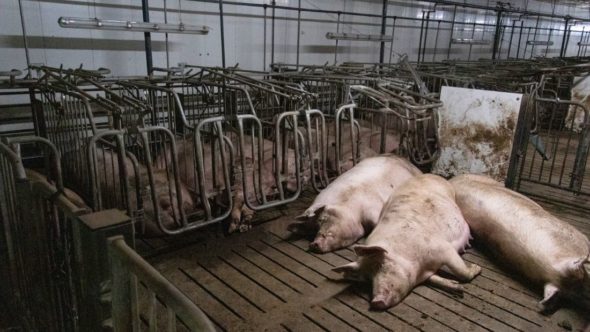
Farrowing
Farrowing is the name given to the process of giving birth in pigs. The cycle of continual farrowing for a sow begins when she is just six to eight months old – her role is to produce the maximum number of piglets.
Due to selective breeding the average litter size of a commercially farmed sow in the UK is now 13 piglets per litter – meaning it is often bigger. The top 10 per cent of UK herds, named by the industry as ‘hyper-prolific’, may give birth to 16 piglets a litter, their close wild relatives, wild boar, have four to seven piglets.
Increased litter sizes means that piglets are more likely to die before they are even born, or before they are weaned. It also follows that the number of piglets born can often exceed the number of teats that the sow has – usually about 14. For this reason, ‘cross-fostering’ is commonplace, where piglets are adopted by another sow.10Pigworld.co.uk. 2013. Effective cross-fostering maximises rearing capacity. Available at: http://www.pig-world.co.uk/features/animal-health-features/effective-cross-fostering-maximises-rearing-capacity.html
A sow’s gestation period is around three months and three weeks and a week before she is ready to give birth, she will be moved to a farrowing crate in indoor systems, or a farrowing arc in outdoor systems.
What is a farrowing crate?
The farrowing crate is a metal frame or cage only centimetres larger than the sow’s body which she will remain for up to four weeks after giving birth to her piglets.
She is unable ever to turn around, can scarcely take a step forward or backwards, and frequently rubs against the bars when standing up and lying down. Farrowing crates are used for around 60 per cent of all British sows.11Driver. A. 2019. Why the pig industry uses farrowing crates. Available at: http://www.npa-uk.org.uk/Why_the_pig_industry_uses_farrowing_crates.html

Sows are naturally active and would build a nest in the week before giving birth, yet in a farrowing crate, she can fulfil none of her natural nesting behaviours. When her babies are born, she is unable to mother or nurture them and they find it almost impossible to nestle beside her, other than to reach her teats for milk.
Newborn piglets have no ability to regulate their temperature and in a natural environment, the nest would provide the warmth they need. In intensive farming, it is provided by heat lamps inside the stall, which draw the piglets away from their mother’s side in the early days after birth.
The sow will remain like this for up to five weeks, until her piglets are artificially weaned at around 21 to 28 days.2Gellatley. J. 2016. Pig Farming the Inside Story. Available at: https://www.viva.org.uk/pig-farming-report/
The pig industry says that the reason for using farrowing crates is to ‘protect piglet welfare and stock person safety’.11Driver. A. 2019. Why the pig industry uses farrowing crates. Available at: http://www.npa-uk.org.uk/Why_the_pig_industry_uses_farrowing_crates.html However, this is disingenuous as piglet mortality is roughly the same in outdoors units where farrowing crates are not used.12Edwards, S. 2011. Pigs. Management and welfare of farmed animals. UFAW Farm Handbook.
Sow stalls
Until 1999, in the UK sows had not only to tolerate the farrowing crate but when not farrowing had to spend their entire lives in other, equally restrictive cages called sow stalls. They were held captive for life – never able to turn around or interact with other animals, not even their babies.
The only break in this imprisonment was when they were transferred from one type of cage to another.
In sow stall units it was common to see widespread stereotypic behaviour – the constant repetition of a pointless movement. It is a sign of mental collapse.
Although now banned in the UK, sow stalls are in common use across the world. They remain legal in most of the USA, Brazil and for the first four weeks after being made pregnant in most EU countries – including those where the UK imports most of its pork from.
They are used, for similar reasons to the crate – for the convenience of the factory farm corporations. Stalls and crates stop the sow from turning around. They force the sow to face forwards, towards a feeder and watering device. And her manure will be deposited in a smaller location as her rear end is very limited in its range of motion as well. They are contraptions that enable a corporation to farm as many breeding females as possible in any given space.
The animals are treated as commodities not living, feeling beings.
Farrowing arcs
The 40 per cent of sows who are not placed in farrowing crates to give birth are kept outdoors and are provided with farrowing ‘arcs’ – individual units constructed of corrugated metal, usually in a field.13AHDB.org. 2020. Outdoor farrowing environment. Available at: https://ahdb.org.uk/knowledge-library/outdoor-farrowing-environment [Accessed 31 May 2020] She is free to come and go as she pleases, but her piglets are confined to the arc for the first two weeks. They will still be weaned too early, at three to four weeks old and the vast majority are moved to intensive indoor systems and never see their mothers again.
About 40 per cent of breeding sows are kept outdoors, however only seven per cent of piglets are reared outdoors after weaning, most of those are then brought indoors leaving only two per cent remaining outdoors until slaughter.14CPRE.org.uk. 2019. The future of pig and poultry farming. Available at: https://www.cpre.org.uk/wp-content/uploads/2019/11/The_future_of_pig_and_poultry_farming.pdf
This means that 98 per cent of pig meat comes from animals that have spent most if not all of their short lives indoors.
Death
In commercial pig farming, more than one in ten piglets (12 per cent) may die before they reach weaning age. Most deaths occur in the first few hours of life, either from crushing, starvation or hypothermia.
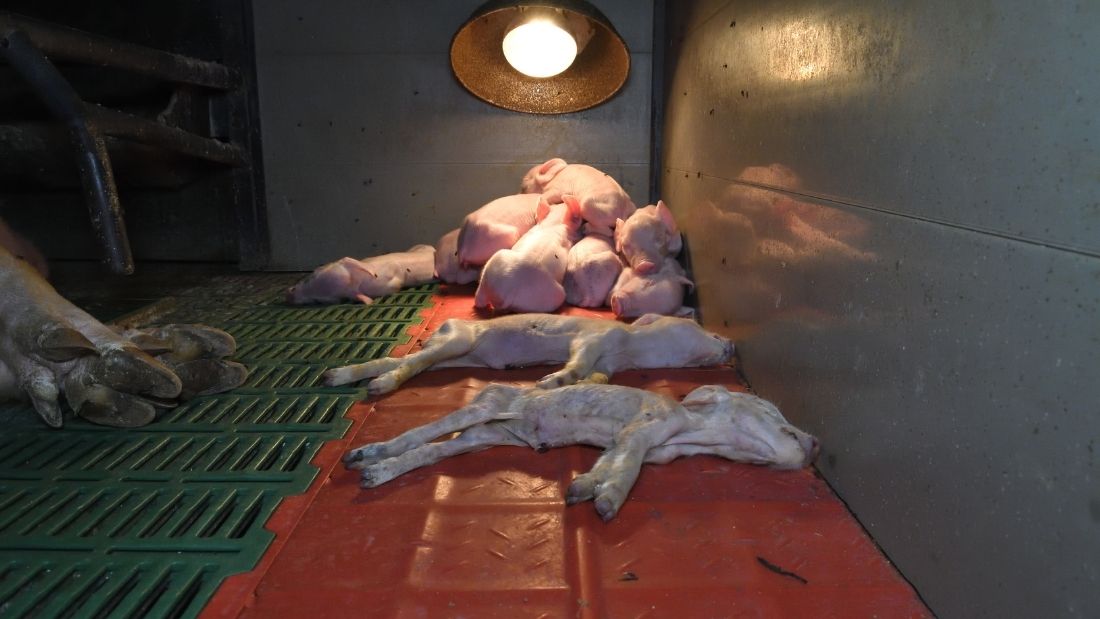
The unnatural construct of commercial farming makes it virtually impossible to create a system that completely eliminates the death of piglets. Sows have been selectively bred to produce more than double the number of piglets they would naturally and in sterile factory farm environments they are unable to build nests to protect their young.
Sows in both indoor and outdoor systems are killed at three to five years old, when they stop being productive, and are sold as ‘low grade’ meat.2Gellatley. J. 2016. Pig Farming the Inside Story. Available at: https://www.viva.org.uk/pig-farming-report/
Weaning
Piglets are forcibly weaned off their mothers’ milk and on to solid food at around three to four weeks old. Naturally, a sow wouldn’t wean her piglets until they were at least 12 to 15 weeks old.2Gellatley. J. 2016. Pig Farming the Inside Story. Available at: https://www.viva.org.uk/pig-farming-report/
This early weaning not only causes emotional stress to both mothers and babies but plays havoc with piglets’ under-developed digestive systems. They do not yet have the digestive enzymes to be able to cope with solid food and the result is often severe diarrhoea, known as scours. Not receiving essential antibodies from their mother’s milk also leaves piglets more susceptible to disease.
To prevent diarrhoea and disease, piglets are put on medications and antibiotics until they reach slaughtering age. Iron supplements are also given to replace the iron that would be passed down in their mother’s milk if she was able to root outdoors in soil.15Towers, L. 2015. Are Your Piglets Iron Deficient? – Causes, Signs and Treatment. Available at: https://thepigsite.com/articles/are-your-piglets-iron-deficient-causes-signs-and-treatment
Piglets are subjected to mutilations before they are weaned. Tail docking (slicing off most of the tail) and teeth clipping (snapping off the four most prominent teeth) are carried out, supposedly to prevent damage to each other from aggressive behaviour as the pigs grow bigger.
Tail docking

Photo: Andrew Skowron
Tail docking is where a large part of the piglet’s tail is removed using a scalpel, clippers or cauterising iron. It is usually done before a piglet is one week old when there is no requirement to use anaesthetics – but it still causes pain and distress.
It is done in an attempt to stop pigs from tail biting – a serious welfare issue in commercially farmed pigs. It often progresses from nibbling at the ends of a pen mate’s tail to biting off chunks, which can then lead to biting off the whole tail. Once blood is drawn, the behaviour escalates and can lead to cannibalisation.
Overcrowding, severe boredom and frustration, poor and monotonous diets and bad air quality in factory farms are thought to increase the likelihood of tail biting. It is not a behaviour seen in sanctuaries or in the wild.16Sonoda et al. 2013. Tail biting in pigs – causes and management intervention strategies to reduce the behavioural disorder. A review. Berl Munch Tierarztl Wochenschr 126(3-4)104-12
Even with tail docking, tail biting is still very common in factory farms. Viva! has uncovered multiple instances of severe tail biting and subsequent cannibalism.
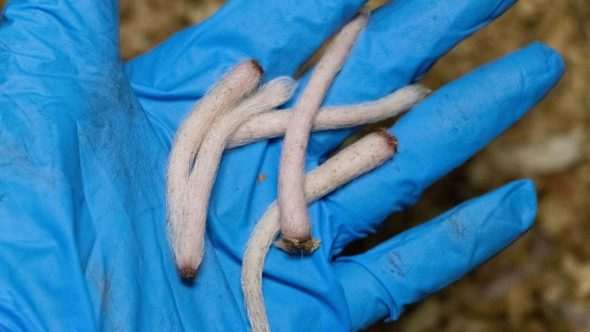
According to the pig industry, 70 per cent of pigs are tail docked in the UK,17Pigworld.co.uk. 2017. Highlighting the differences – how UK welfare standards compare with our competitors. Available at http://www.pig-world.co.uk/news/highlighting-the-differences-how-uk-welfare-standards-compare-with-our-competitors.html#:~:text=Very%20few%20organic%20pigs.&text=UK%20and%20most%20of%20the,important%20antibiotics%20for%20production%20purposes. [Accessed 3 July 2020] despite routine tail docking being against the government’s Code of Practice for the Welfare of Pigs.
Teeth clipping

Teeth clipping can be carried out on newborn piglets to prevent their sharp teeth from damaging a sow’s teat during feeding. Their needle teeth are either snapped off with clippers or ground down to gum level, which opens the pulp cavity.
It is clearly a painful mutilation yet no anaesthetics or pain relief is given. When carried out carelessly it causes splintering of the teeth and damage to the gums, causing chronic pain and infection.2Gellatley. J. 2016. Pig Farming the Inside Story. Available at: https://www.viva.org.uk/pig-farming-report/
Teeth clipping is supposedly no longer permitted as a ‘routine’ procedure in the UK but can be done when ‘other management options have proven to be ineffective and at the recommendation of a veterinary surgeon’.
Despite this caveat, most piglets are mutilated in this way.
Piglet castration
Piglet castration without anaesthesia was traditionally performed to make the management of boars easier and to prevent ‘boar taint’ – where the taste of meat is spoiled by testosterone from a maturing animal. Because pigs are now slaughtered at such a young age, castration is uncommon in the UK.
Chemical castration is still permitted but banned under the Red Tractor scheme which covers 94 per cent of UK pig production.18Clarke, P. 2020. No alternatives to culling day old male chicks… yet. Available: https://www.fwi.co.uk/livestock/poultry/layers/no-alternatives-to-culling-day-old-male-chicks-yet?name=no-alternatives-to-culling-day-old-male-chicks-yet&category_name=livestock%2Fpoultry%2Flayers
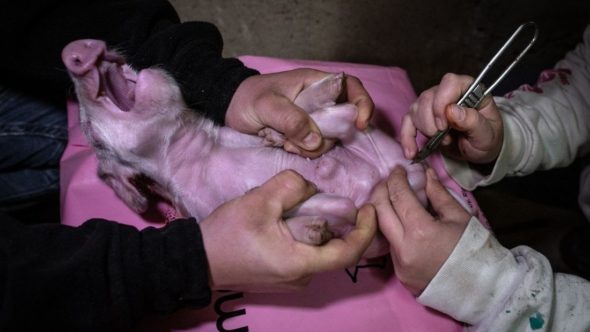
Photo: Konrad Lozinski
Growing sheds
‘Weaner’ piglets are those newly taken from their mothers and kept with piglets from other litters in ‘growing sheds’, usually on barren, ‘flat deck’ floors with rough surfaces, until they are around 10 weeks old. These environments offer no stimulation and very little opportunity to play.
Like young children, piglets have a short attention span and play is very important to their development. Denying them the ability to play leads to behavioural abnormalities in later life.19Studnitz, M., Jensen, M.B. & Pedersen, L.J. (2007). Why do pigs root and in what will they root? AQ review on the exploratory behavior of pigs in relation to environmental enrichment. Applied Animal BehaviorScience, 107, 183–197.

Finishing/Fattening
At around 10 weeks old piglets are moved from growing sheds to ‘fattening’ or ‘finishing’ sheds, where they will stay until they reach their final slaughter weight of 100kg or more.
Almost all pigs, even if born outside, will be moved into indoor finishing sheds for fattening.
Both growing and finishing stages have one main objective – to grow pigs to slaughter weight as rapidly as possible. The most common type of housing for both systems is in controlled-environment buildings with fully or partly slatted floors where faeces can supposedly be flushed through.
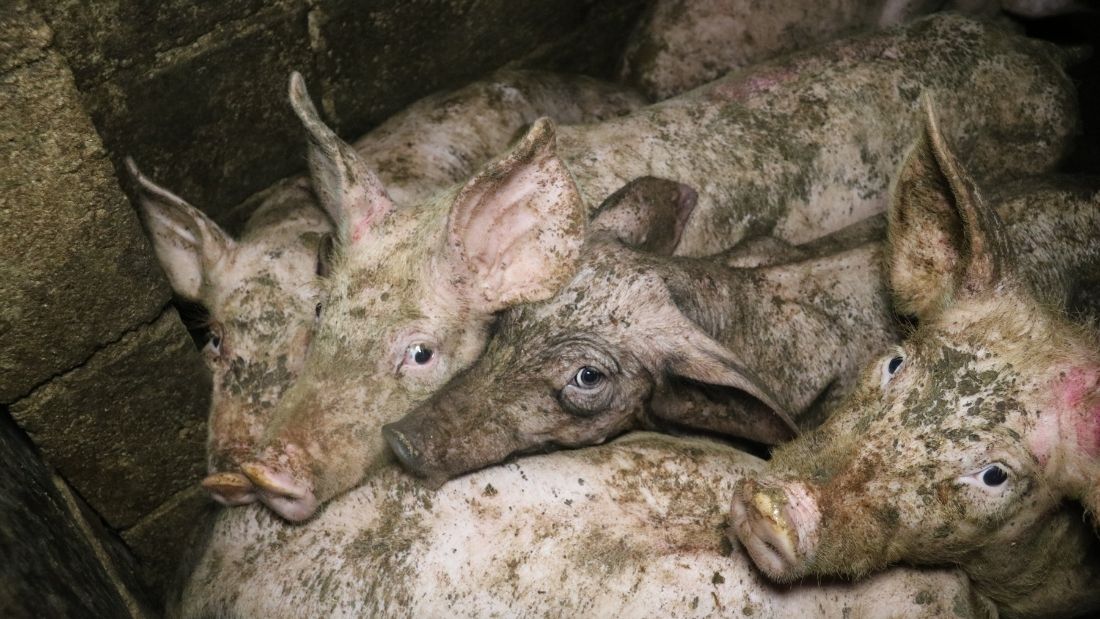
Although straw is recommended to enable pigs to carry out rooting behaviour, it is not enforced with slatted floor systems and so around 40 per cent of pigs in finishing sheds are kept in barren concrete pens with no straw bedding and nothing that enables them to fulfil their natural instincts.20Driver, A. 2017. Highlighting the differences – how UK welfare standards compare with our competitors. Available at: http://www.pig-world.co.uk/news/highlighting-the-differences-how-uk-welfare-standards-compare-with-our-competitors.html
Crowding is usual, with as little as one square metre of space for fully grown pigs of 110kg.21Defra. 2020. Code of Practice and Welfare for pigs. Available at: https://assets.publishing.service.gov.uk/government/uploads/system/uploads/attachment_data/file/869140/code-practice-welfare-pigs.pdf
There is no opportunity for them to wallow in mud as they would in the wild, so instead, they attempt to wallow in their own excreta, increasing the risk of disease transmission. As they are unable to lower their temperature naturally, temperature and air quality inside sheds is supposedly strictly regulated to prevent heat stress.
It is recommended that farmed pigs should be provided with ‘enrichments’ to allow them to carry out some of their natural behaviours, but these are usually minimal and are token gestures to satisfy recommendations such as a hanging chain inside their pen, or giving them an old football or a dirty plastic bottle to play with – items that lose their novelty value very quickly.
Such objects, therefore, do little to alleviate the stress of their unnatural and overcrowded environments, and the result is frequently boredom, frustration and problematic behaviour such as tail biting, bullying and even cannibalisation. Pigs are emotionally sensitive animals and when placed under extreme stress and confinement they suffer.
The lives of all pigs bred for meat in the UK end at five to six months old.2Gellatley. J. 2016. Pig Farming the Inside Story. Available at: https://www.viva.org.uk/pig-farming-report/
‘Highest welfare standards’ – a sick joke
Despite the UK pig industry promoting itself as having some of ‘the highest welfare standards in the world’, only two per cent of pigs spend the entirety of their short lives outdoors.14CPRE.org.uk. 2019. The future of pig and poultry farming. Available at: https://www.cpre.org.uk/wp-content/uploads/2019/11/The_future_of_pig_and_poultry_farming.pdf
Two to three per cent of finishing pigs will be kept in free-range outdoor systems until slaughter and just 0.6 per cent are farmed organically.20Driver, A. 2017. Highlighting the differences – how UK welfare standards compare with our competitors. Available at: http://www.pig-world.co.uk/news/highlighting-the-differences-how-uk-welfare-standards-compare-with-our-competitors.html
Around 40 per cent of indoor finishing pigs are kept in barren, crowded stalls with no straw bedding but just slatted flooring for their faeces to drop through. The remaining 60 per cent of indoor pigs are supposedly given straw bedding but unless it is changed regularly it does little to improve their environment. Even with straw, they are still housed in crowded conditions with a minimum of 0.65 metre squared per 100kg pig.21Defra. 2020. Code of Practice and Welfare for pigs. Available at: https://assets.publishing.service.gov.uk/government/uploads/system/uploads/attachment_data/file/869140/code-practice-welfare-pigs.pdf

Intensive farms are on the rise
The number of intensive pig farms is rising rapidly. There are currently 252 industrial indoor units in the UK, up five per cent since 2017.
To count as intensive, farms must raise more than 2,000 pigs for meat or breed more than 750 sows. The largest pig farms in the UK can hold more than 23,000 pigs.22Colley, C & Wasley, A. 2020. Industrial-sized pig and chicken farming continuing to rise in UK. Available at: https://www.theguardian.com/environment/2020/apr/07/industrial-sized-pig-and-chicken-farming-continuing-to-rise-in-uk
These mega farms require special environmental permits and applications are often opposed by local communities, environmental groups and animal rights organizations. Viva! regularly opposes plans for industrialised farms which often result in them being rejected by local councils.
Diseases
Diseases run rife in factory farms where overcrowded conditions, combined with the low immune systems of stressed pigs, create a breeding ground for diseases and infections to spread.
Respiratory diseases are a big problem for pig producers and enzootic pneumonia (constantly present) is estimated to affect 80 per cent of the UK herd.23NADIS.org.uk. 2020. Enzootic pneumonia. Available at: https://www.nadis.org.uk/disease-a-z/pigs/enzootic-pneumonia/ [Accessed 31 May 2020] Some diseases, such as pleuropneumonia, can kill 30-50 per cent of those pigs who are infected. Porcine Respiratory Disease Complex (PRDC) is another common viral infection that weak, new-born piglets are particularly susceptible to.
Currently, African Swine Fever (ASF) is a pandemic in pigs and is the most significant threat to the global pig population seen in modern times. The World Health Organisation (WHO) predicts that this viral disease will have killed a quarter of the world’s 800 million pigs before the epidemic is brought under control.24Riley, J. 2020. African swine fever threat: What farmers need to know. Available at: https://www.fwi.co.uk/livestock/health-welfare/livestock-diseases/african-swine-fever-threat-what-farmers-need-to-know The disease, which causes fever, vomiting, bloody diarrhoea and blood clots to develop in the bloodstream, has a death rate of nearly 100 per cent.25Standaert, M. 2020. ‘Unstoppable’: African swine fever deaths to eclipse record 2019 toll. Available at: https://www.theguardian.com/environment/2020/may/27/unstoppable-african-swine-fever-deaths-to-eclipse-record-2019-toll#maincontent
Foot and mouth disease is a highly contagious viral disease that spreads like wildfire among farmed cows, sheep, goats and pigs. In 2001, it led to farmers killing millions of their animals.
Swine flu
Diseases in pig farms aren’t just a threat to the pig population, they are also a threat to humans.
Swine flu is the popular name for a relatively new strain of the H1N1 influenza virus that was responsible for the flu pandemic of 2009 and 2010. The virus contains genes from pig, chicken and human viruses and was aided and abetted by factory farming.
The first cases were reported in California and Texas and it then spread rapidly around the world , killing between 150,000 and 575,000 people in its first year, before a vaccine was developed.26Butler, J, 2020. Zoonoses: a ticking timebomb. Viva!. Swine flu has now joined the pantheon of other types of flu that lead to outbreaks every winter.
Injuries and death
Lameness is common in farmed pigs and can be caused by infection, injury or underlying diseases. These injuries often take the form of calluses, swellings, wounds and abscesses. Foot rot is a bacterial infection, made worse by the urine-soaked conditions on most shed floors and is another common problem that can cause ulcers and sepsis.
Viva! has exposed pigs suffering from extreme lameness, injury and abscesses in Red Tractor approved farms.

These conditions inevitably take a severe toll on some pigs and many die before even reaching slaughter age. Although sick pigs are supposed to be moved to separate pens, Viva!’s investigations have uncovered sick and dead pigs dumped in gangways, often for several days and sometimes left there to die.
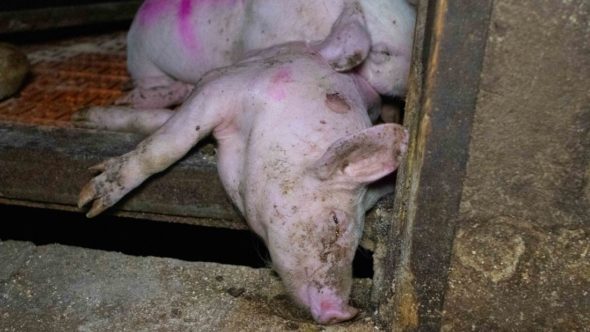
Antibiotics in pig farming
Factory farm environments are fertile grounds for disease and injury and consequently, antibiotics are widely used in order to get pigs to slaughter age.
Until 2006, three types of antibiotic were used – one to prevent diseases (prophylactic), one to cure diseases (therapeutic) and one simply to make animals grow faster (growth promoters). Growth- promoting antibiotics were banned by the EU (which also applied to the UK) in 2006 but the other types are still permitted.
The growth of antibiotic-resistant superbugs is now a global threat to health and England’s Chief Medical Officer for Health, Professor Dame Sally Davis, claims that we are facing a ‘post-antibiotic apocalypse’.27Donnelly, L. 2017. Britain could face ‘post-antibiotic apocalypse’ warns top doctor . Available online at: https://www.telegraph.co.uk/news/2017/10/13/britain-could-face-post-antibiotic-apocalypse-warns-top-doctor/
Despite the pressure on livestock farmers to reduce their antibiotic use due to the global threat of antibiotic resistance [link to AR section of website], at least one third of all antibiotic use in the UK is attributed to livestock, with pig and poultry factory farms being the worst offenders.28Harvey, F. 2018. UK medics call for government ban to cut antibiotic resistance. Available at: https://www.theguardian.com/society/2018/nov/16/uk-medics-call-for-government-ban-to-cut-antibiotic-resistance.29Gov.uk.2019. UK One Health Report Joint report on antibiotic use and antibiotic resistance, 2013–2017. Available at: https://assets.publishing.service.gov.uk/government/uploads/system/uploads/attachment_data/file/775075/One_Health_Report_2019_v45.pdf
In the U.S, Canada and Brazil – three of the world’s biggest pork producing countries – antibiotics can still be used to promote fast growth and livestock in these countries account for up to 80 per cent of all antibiotic use.30Martin, Michael J et al. “Antibiotics Overuse in Animal Agriculture: A Call to Action for Health Care Providers.” American journal of public health vol. 105,12 (2015): 2409-10. doi:10.2105/AJPH.2015.302870
Around 10.9 million pigs are slaughtered in the UK each year.1Agriculture in the UK. 2022. Available at: https://www.gov.uk/government/statistics/agriculture-in-the-united-kingdom-2022/chapter-8-livestock The vast majority – 88 per cent – are killed using a high concentration of CO2 in purpose-built gassing machines.2DEFRA. 2019. Results of the 2018 FSA Survey into Slaughter Methods in England and Wales. Available at: https://assets.publishing.service.gov.uk/government/uploads/system/uploads/attachment_data/file/778588/slaughter-method-survey-2018.pdf
The minimum concentration of CO2 used is 80 per cent.3Gov.uk. 2022. Red meat slaughterhouses: restraining, stunning, killing animals Available at: https://www.gov.uk/guidance/red-meat-slaughterhouses-restraining-stunning-killing-animals [Accessed 15 November 2022] Exposure of conscious pigs to the gas must lead to loss of oxygen to the brain (anoxia). Pigs often violently struggle for up to 30 seconds before losing consciousness as the gas forms an acid on their eyes, nostrils, mouths and lungs and burns their insides.
The suffering this causes the pigs has led to calls for the practice to be banned. In 2020, EFSA (European Food Safety Authority) published a report on the welfare of pigs at slaughter. A panel of scientists concluded: “Exposure to CO2 at high concentrations (higher than 80% by volume) is considered a serious welfare concern because it is highly aversive and causes pain, fear, and respiratory distress”.
- Find out more about pig gassing in the UK
Almost all the remaining 14 per cent of pigs are stunned through electronarcosis,2DEFRA. 2019. Results of the 2018 FSA Survey into Slaughter Methods in England and Wales. Available at: https://assets.publishing.service.gov.uk/government/uploads/system/uploads/attachment_data/file/778588/slaughter-method-survey-2018.pdf where an electric current is passed through the brain of the animal. A device a bit like a large pair of tongs is used with an electrode on each of the two extremities. These electrodes are clamped on either side of the animal’s head and a current is passed through the brain, supposedly rendering the animal unconscious.
There are too many variables that can and often do go wrong – the current is too weak, the slaughterer does not apply the electrodes to the correct part of the head, and fails to hold them in position for the required length of time to make the stun properly effective.
The result can be that the stun is short-lived and the animal regains consciousness before his or her throat is cut. Viva! has filmed this happening with both pigs and sheep.
No matter which way they are stunned, the pig will then go through a process called sticking where they will be hung up by their hind legs on hooks and have their throat cut until they bleed out (bleed to death). It is not uncommon for pigs to still be partly conscious at this point and to thrash around on the hooks until they lose consciousness.5Viva.org.uk.2020. THE SLAUGHTER OF FARMED ANIMALS IN THE UK. Available at: https://www.viva.org.uk/what-we-do/slaughter/slaughter-farmed-animals-uk#:~:text=Viva!,as%20they%20bleed%20to%20death.&text=Pigs%20are%20supposed%20to%20be,and%20then%20’bled%20out’. [Accessed 8th June 2020]
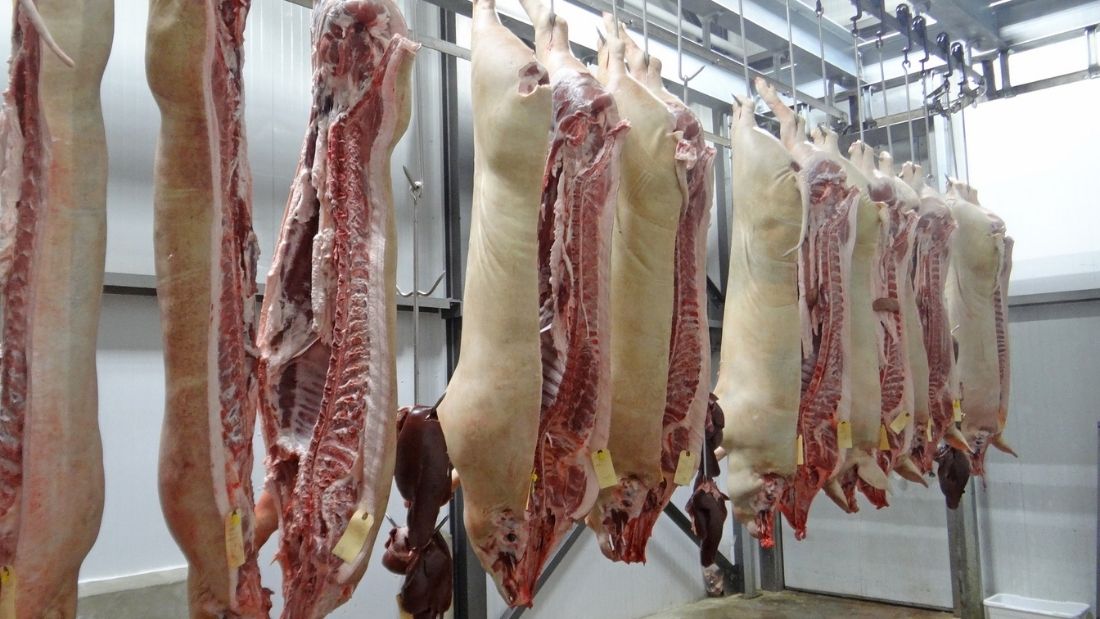
Where does British pig meat go?
Despite the number of pigs farmed in the UK, it is not self-sufficient in pork and imports 60 per cent of its consumption from other EU countries. It is a two-way trade and the UK exports 30 per cent of its pig meat to EU and non-EU countries.6AHDB.org.uk. 2020 Pig meat trade. Available at: https://ahdb.org.uk/pork/pig-meat-trade [Accessed 31 May 2020]
Is Your Breakfast Worth His Life?
Suggested caption: He will spend his life on a factory farm, forced to live with hundreds of other animals in their own filth with no access to the outside. He will be slaughtered before he is even a year old, all so people can eat meat. Is your breakfast really worth his life?
The Only Difference is Your Perception
Suggested caption: Both babies, both sentient, both deserving of love. Why love one but eat the other?

